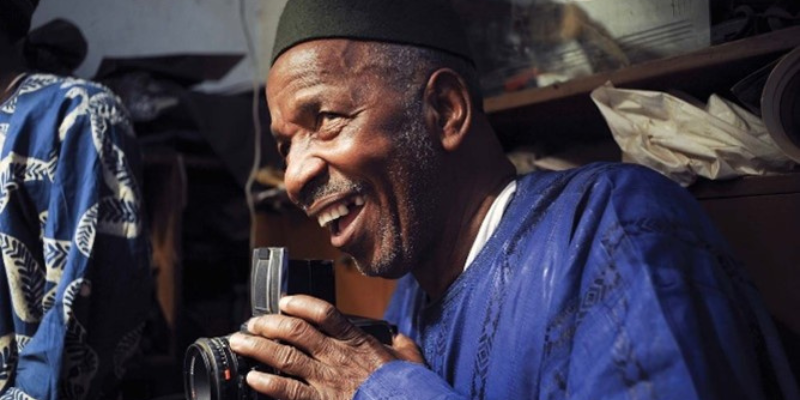In the photographs of Malick Sidibé, one finds the essence of life spilling over, transcending the space between the viewer and the subjects within the photograph. There is movement, spirit, and community- all gathered during a pivotal time in Malian history, immediately after its independence from French colonial rule. Sidibé’s work is renowned today for depicting urban life, youth interactions and popular culture from the period, and authentically capturing wide-scale socio-economic transition. There is also agency showcased in these photographs, where a once colonized country comes into its own- the people reflect this mixture of the old and new, adapting both the native and the Western in their ways. Sidibé, thus, provides glimpses into a society where identities were being stitched together and the native lens was crucial to decipher this change- but also, he greatly enjoyed immortalising moments where people felt the most alive.
Knowing Malick Sidibé
Born in Soloba, Mali in 1936, Sidibé was known for his illustration skills at a young age. His mother decorated houses with traditional patterns, and he took up drawing upon entering school. Sidibé describes his early pieces as having a great affinity with nature and natural imagery, a fact he remained proud of. His skills were eventually hired for official school events including the painted pieces of cloth that were sent out to officials on French Independence Day and New Year celebrations. It may have been this, according to Sidibé, that led to a Major selection of him to attend the School of Sudanese Craftsmen in the capital, Bamako.
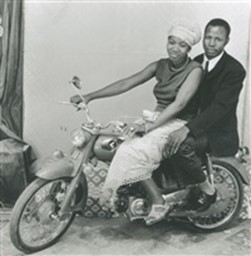
Source: Artnet
After finishing his education there, he was hired by Frenchman Gérard Guillat-Guignard to paint the interiors of his photo studio- ‘Photo Service’. On continuing to work there as a cashier and assistant, Sidibé eventually learned to use a camera and print negatives. In 1956, he bought his first camera- a Brownie Flash- and began to take up work on his own at the studio. As Sidibé recalls, he took up the orders from African clients and Guillat-Guignard worked for the European ones. By 1957, Sidibé had become famous in his own right, both as a photographer for all events-from parties to weddings and also as a repairer of cameras, in the wider region. When he set up his own studio- ‘Studio Malick’ in 1963, he had a well-established network of clients, with most of the West African clientele from Photo Service following him. In the years that followed, Sidibé grew as a prominent photographer who shot events of cultural and national significance. He photographed musicians like Nahawa Doumbia, worked as a photographer in fashion for many publications including Vogue and later experimented with new styles of photography. A recipient of several accolades, including the Golden Lion Award for Lifetime Achievement at the Venice Biennale in 2007, his work has been displayed in many institutes of international repute, the Museum of Contemporary Art, Chicago and the Stedelijk Museum in Amsterdam being a couple of them. Sidibé passed away in 2016 at the age of 80, he was laid to rest at Soloba, with his mother.

Source: Artnet
What made Sidibé’s work unique?
The Youth in Sidibé’s Pieces
“When you look at my photos, you are seeing a photo that seems to move before your eyes…People who have life need to be positioned that way.” said Sidibé, referring to his studio portraits. The liveliness he tried to preserve is abundant in his shots- of carefree youth, laughing families and earnest subjects. There is an understanding of the subject and their wants, that he caters to as the photographer. When talking about the youth he has on film, he remembers being invited to parties regularly. He reminisces in an interview about how he would spend from midnight to between 4 a.m. and 6 a.m. attending parties, taking pictures, developing them overnight and finally displaying them for an audience of young people who tried to find themselves in the visuals. His works such as Nuit de Noël (Happy Club) portray a young couple dancing together, the joy of being present in the moment is crisp.
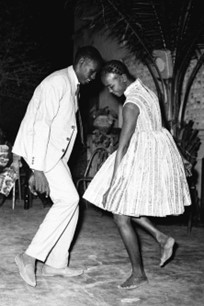
Source: Somerset House
The relaxed social norms that allowed men and women to interact at such events are also recorded in such photos. Commenting on this, Sidibé notes that young people often enjoyed getting their photos taken to simply show their friends, even if they could not afford to buy them. The recognition of their need to hold on to a fleeting memory, to flaunt the women they were able to dance with, may have contributed to Sidibé’s popularity. This, in turn, allowed him to capture trends, fashion styles, urban ways of living and the celebratory spirit of Malian youth unlike ever before. In the inviting gaze of Look at Me!, Sidibé’s signature style of capturing people in action gives dynamism to the photo, which remains rippling with life decades later. There were also crucial socio-cultural elements captured in these images, from the setting to the exercise of new-found freedoms.
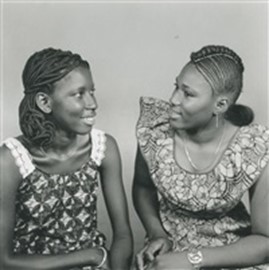
Source: Artnet
Speaking of the relevance of Sidibé’s works featuring the youth, writer and art historian Manthia Diawara notes, “They show exactly how the young people in Bamako had embraced rock and roll as a liberation movement, adopted the consumer habits of an international youth culture, and developed a rebellious attitude towards all forms of established authority.”
Sidibé’s other works
In his portraits and studio photos too, Sidibé took care to safeguard the living quality of his subjects in the images. They were deliberately positioned in shots involving movements- he simply refused to offer rigid poses to his clients. Sidibé’s black and white style carried on to these photos too, which were accompanied by patterned backgrounds- that sometimes deliberately clashed with the subjects. Later in his career, Sidibé worked on more thematically creative collections like Vue de Dos (Back Views) featuring women turned away from the camera. Sidibé used these intimate and powerful images to subvert the power in the camera’s gaze, offering it instead to the women who only show the lens their backs.
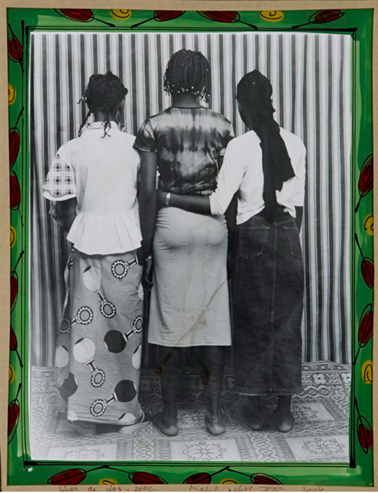
Source: The Studio Museum in Harlem
What does his work leave behind?
When enquired about the reason behind the success of his studio, Sidibé remarks that its laid-back nature- where he forces nothing on his clients, and they are free to be in their own worlds- is a reason. Sidibé’s subjects are allowed agency, be it riding a motorcycle or dancing to their favourite song at a party. Additionally, he also quotes community engagement to be helpful, people need to know, like, and trust the person behind the camera. The sense of freedom enjoyed by his subjects is also carefully curated memoirs of a nation’s new freedoms, that Sidibé recorded through his camera. His raw captures act as a time capsule for a time of assured discovery and cultural resilience. Sidibé’s deep sense of understanding and respect for humanity, which he embraces with all its untameable aspects, causes him to refuse to constrain it to what is socially acceptable. The effortless joy, the layered humanity and enthusiasm seen in his pieces, perhaps can only be created with this refusal.
SOURCES:
- Artnet-Malick Sidibe
- Guggenheim-Malick Sidibe
- Lensculture-Malick Sidibe Interview
- MoMA
- Studio Museum
Read Also:
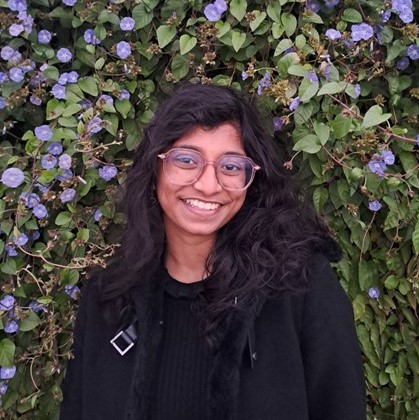
Contributor

